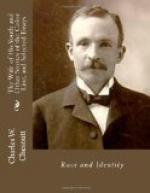They followed one of the least handsome streets of the city for more than a mile, turned into a cross street, and drew up before a small frame house, from the front of which a sign, painted in white upon a black background, announced to the reading public, in letters inclined to each other at various angles, that whitewashing and kalsomining were “dun” there. A knock at the door brought out a slatternly looking colored woman. She had evidently been disturbed at her toilet, for she held a comb in one hand, and the hair on one side of her head stood out loosely, while on the other side it was braided close to her head. She called her husband, who proved to be the Patesville shoemaker’s brother. The hackman introduced the traveler, whose name he had learned on the way out, collected his quarter, and drove away.
Mr. Johnson, the shoemaker’s brother, welcomed uncle Wellington to Groveland, and listened with eager delight to the news of the old town, from which he himself had run away many years before, and followed the North Star to Groveland. He had changed his name from “Williams” to “Johnson,” on account of the Fugitive Slave Law, which, at the time of his escape from bondage, had rendered it advisable for runaway slaves to court obscurity. After the war he had retained the adopted name. Mrs. Johnson prepared breakfast for her guest, who ate it with an appetite sharpened by his journey. After breakfast he went to bed, and slept until late in the afternoon.
After supper Mr. Johnson took uncle Wellington to visit some of the neighbors who had come from North Carolina before the war. They all expressed much pleasure at meeting “Mr. Braboy,” a title which at first sounded a little odd to uncle Wellington. At home he had been “Wellin’ton,” “Brer Wellin’ton,” or “uncle Wellin’ton;” it was a novel experience to be called “Mister,” and he set it down, with secret satisfaction, as one of the first fruits of Northern liberty.
“Would you lack ter look ‘roun’ de town a little?” asked Mr. Johnson at breakfast next morning. “I ain’ got no job dis mawnin’, an’ I kin show you some er de sights.”
Uncle Wellington acquiesced in this arrangement, and they walked up to the corner to the street-car line. In a few moments a car passed. Mr. Johnson jumped on the moving car, and uncle Wellington followed his example, at the risk of life or limb, as it was his first experience of street cars.
There was only one vacant seat in the car and that was between two white women in the forward end. Mr. Johnson motioned to the seat, but Wellington shrank from walking between those two rows of white people, to say nothing of sitting between the two women, so he remained standing in the rear part of the car. A moment later, as the car rounded a short curve, he was pitched sidewise into the lap of a stout woman magnificently attired in a ruffled blue calico gown. The lady colored up, and uncle Wellington, as he struggled to his feet amid the laughter of the passengers, was absolutely helpless with embarrassment, until the conductor came up behind him and pushed him toward the vacant place.




